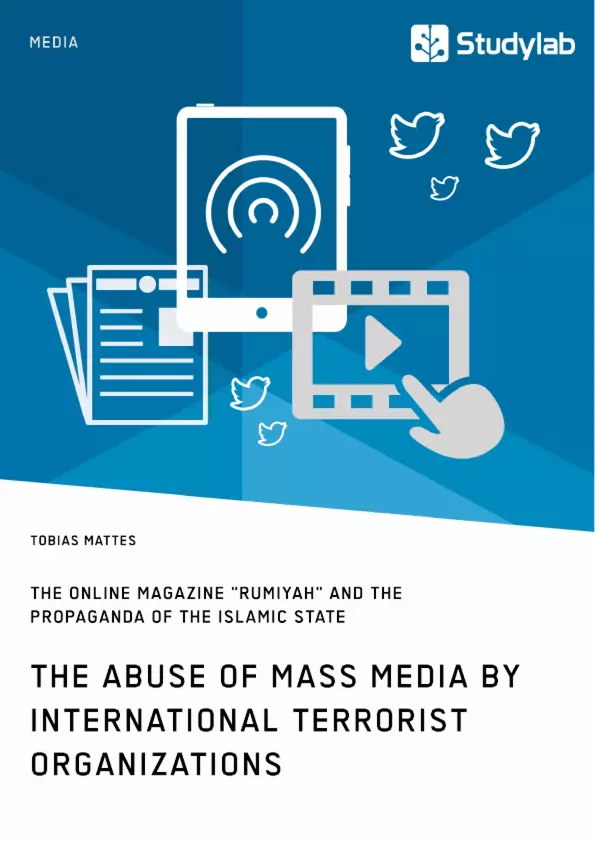In the age of globalization and social media, Europe is facing a new wave of terrorism. Most often, the jihadists are associated with the Islamic State (IS). Their number is growing rapidly due to massive online propaganda. But how exactly is radicalization promoted by the Islamic State? What are the challenges for security authorities?
Tobias Mattes explains recent findings of radicalization research. Moreover, he analyses the online magazine “Rumiyah” in order to find out which triggers promote radicalization. His publication helps to understand the messages propagated through this magazine and how this knowledge can be used by governmental agencies for a counter-strategy against Islamic State’s radicalization attempts in online jihad.
In this book:
- Radicalization;
- Islamic State;
- Jihad;
- Terrorism;
- Deradicalization;
- Online propaganda
Inhaltsverzeichnis (Table of Contents)
- Abstract
- List of Abbreviations
- List of Figures
- The Islamic Glossary
- Dedication
- Abstract
- 1 Introduction
- 1.1 Introduction to the theme
- 1.2 Question of research
- 1.3 Limitations
- 1.4 Method of research
- 1.5 Status and gap of research
- 2 Category System
- 2.1 Scientific findings of radicalization research (theoretical framework)
- 2.2 Design of the category system
- 2.3 Interim conclusion
- 3 Description research material
- 3.1 Islamic State and new media
- 3.2 Al Hayat Media Center - the media department
- 3.3 "Rumiyah" - the magazine
- 3.4 Interim conclusion
- 4 Results of the analysis
- 4.1 Content analysis
- 4.2 Layout description
- 4.3 Interim conclusion
- 5 Comparison with the findings about the "DABIQ" magazine
- 5.1 Comparison of content analysis findings
- 5.2 Comparison of layout analysis findings
- 5.3 Interim conclusion
- 6 Possible counter measures
- 6.1 Possible measures against online propaganda
- 6.2 Possible offline measures after radicalization (deradicalization)
- 6.3 European level approaches
- 6.4 Excursus - "the deradicalization center of the Bavarian police"
- 6.5 Interim conclusion
- 7 Conclusion and suggestions for further research
- 7.1 Conclusion
- 7.2 Suggestions for further research
- 8 References
- 8.1 Analysis material
- 8.2 Literature
- 8.3 Online sources
- 9 Appendix
- 9.1 Definitions
- 9.2 The Islamic State
- 9.3 Development of the police crime statistics
- 9.4 Analysis - Results
Zielsetzung und Themenschwerpunkte (Objectives and Key Themes)
This master thesis aims to provide a qualitative content analysis of "Rumiyah," the monthly magazine published by Al Hayat Media Center, the official Media Department of the Islamic State. The study examines 13 issues of the magazine, focusing on identifying triggers used to promote radicalization. The research delves into the current state of scientific findings on radicalization research, comparing the results of the content analysis with analogous studies on the "Dabiq" magazine. Possible counter-measures are then suggested, exploring their practical implementation. The primary objective is to understand the messages propagated through "Rumiyah" and leverage this knowledge to develop a functional counter-strategy against Islamic State's radicalization attempts in online jihad.
- Analysis of the online propaganda magazine "Rumiyah"
- Identification of radicalization triggers within the magazine's content
- Comparison of findings with research on the "Dabiq" magazine
- Exploration of potential counter-measures against online propaganda
- Development of strategies to counter Islamic State's radicalization attempts
Zusammenfassung der Kapitel (Chapter Summaries)
The introduction of this study provides an overview of the research topic, outlines the research question, limitations, methodology, and existing research gaps. Chapter 2 delves into the theoretical framework of radicalization research and establishes a category system for analysis. Chapter 3 describes the research material, focusing on the Islamic State's use of new media, the Al Hayat Media Center, and the "Rumiyah" magazine itself. Chapter 4 presents the results of the content and layout analysis conducted on "Rumiyah." Chapter 5 compares these findings to previous research on the "Dabiq" magazine. Finally, Chapter 6 explores potential counter-measures to address the spread of online propaganda, including suggestions for deradicalization programs.
Schlüsselwörter (Keywords)
The study focuses on the online propaganda of the Islamic State, specifically examining the "Rumiyah" magazine and its use of radicalization triggers. The analysis explores the content and layout of the magazine, comparing it to the "Dabiq" magazine. The study also delves into potential counter-measures against online radicalization and the development of deradicalization strategies.
- Quote paper
- Tobias Mattes (Author), 2019, The abuse of mass media by international terrorist organizations. The online magazine "Rumiyah" and the propaganda of the Islamic State, Munich, GRIN Verlag, https://www.grin.com/document/442970



